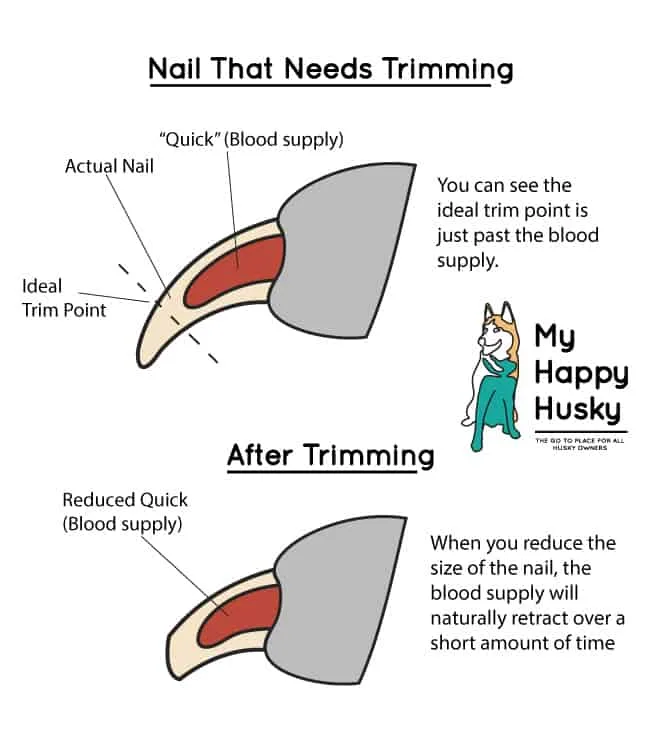Paw care? Yep, it’s important, yet often forgotten about. Let’s run through the best ways to care for your husky’s paws properly.
Taking appropriate care of your husky’s paws will ensure their strength, health, and cleanliness. Neglected paws could lead to issues like ingrown nails, yeast infections, and some unwanted trips to the vet.
3 Quick Reasons Why Paw Care Is Important For Huskies
Caring for your husky’s paws is essential for a few reasons:
Comfort:
Properly cared for paws can help ensure that your husky is comfortable when walking or running. If their paws are dry, chapped, or injured, they may experience discomfort or pain.
Health:
Keeping your husky’s paws clean and free of injuries can help prevent infections and other health problems. For example, if your dog has a cut on their paw that becomes infected, it can lead to more serious health issues.
Performance:
Your husky’s paws play a key role in their ability to run, hike, and participate in other activities. By taking good care of their paws, you can help them maintain their endurance and performance.
Taking care of your husky’s paws is a basic, yet important part of being a responsible pet owner and ensuring your dog’s health and well-being.
Looking After Your Husky’s Paws: 5 Great Tips
Let’s run through the best ways to properly care for your husky’s paws.
1. Nail trimming
It’s crucial to keep your husky’s nails trimmed down to a healthy level. Even if your husky regularly walks on concrete, it doesn’t necessarily mean they will “trim themselves”.
You can shine a light underneath the nail to expose where the quick is “blood supply” vs the nail.

Keeping on top of nail trimming can help prevent long nails from curling around and digging back into the skin. It will also prevent your husky from damaging their own skin too much if they scratch.
2. Wash paws after walks
Wash your husky’s paws after they’ve been outside in public parks and areas. You never know what kind of dirty muck those paws are treading in.
Keeping the paws clean will limit bacteria build-up, and even keep your home cleaner.
Wash with water and a natural ingredient mild pet shampoo. Avoid using a regular pet shampoo or human shampoo. This will dry out the paws and cause further issues.
- Important: Thoroughly DRY the paws after washing!
Leaving the paws wet may cause infections and other problems.
3. Use paw wax in winter
During the icy winter stage, it’s a very good idea to use paw wax when taking your husky outside.
Paw wax will help prevent sores, ice burns, and frostbite when your husky walks in the snow or ice.
Additionally, paw wax puts a protective barrier between those sensitive pads and the harsh ice-melt/salt mixture that is often put down on pathways and walkways out in public areas.
4. Moisturize their paws
It’s a good idea to moisturize your husky’s paws once a week. Keeping the pads moisturized can prevent cracking (especially throughout winter).
Cracked paws can lead to deep wounds, infections, and multiple vet visits. Moisturize once a week with paw balm or petroleum jelly.
5. Regular inspections
Take the time to regularly inspect your husky’s paws. Look on the pads, in-between the toes, and even on the top side under the hair.
Ensure that everything looks healthy and free from cuts, wounds, dirty, bacteria, or infections.
Stop Your Husky From Biting or Nibbling Their Paws
Sometimes your husky may resort to biting or excessively nibbling at their own paws.
First of all this needs to be stopped, but second of all, this indicates that something is stressing out your husky.
Paw biting or nibbling is a classic sign of stress, anxiety, and even depression. These are all serious issues to handle, let alone a raw foot that needs veterinary assistance to help recover.
Excessive paw biting can lead to infected wounds and yeast infections, so it’s vital to identify the true trigger and address it before the nibbling gets out of control.
Disclaimer
The advice given in this article is for educational purposes only and does not constitute professional advice in any context. Before making any decisions that may affect the health and/or safety of your dog, you should always consult a trained veterinarian in your local area. For the FULL disclaimer Visit HereCopyright Notice: The content produced and published on My Happy Husky is unique and original. My Happy Husky makes an active effort to search for plagiarized content using plagiarism detection software. If plagiarized content is found, action will be taken.
